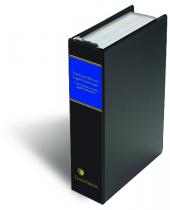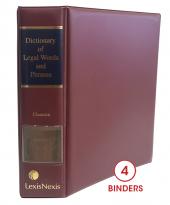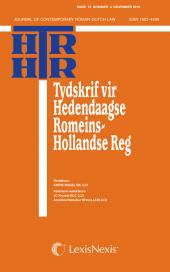The South African Legal Practitioner A commentary on the Legal Practice Act
The South African Legal Practitioner: A commentary on the Legal Practice Act is the first comprehensive handbook on legal practice under the Legal Practice Act.
One Year Subscription Only Terms
Subscribers receive the product(s) listed on the Order Form and any Updates made available during the annual subscription period. Shipping and handling fees are not included in the annual price.
Subscribers are advised of the number of Updates that were made to the particular publication the prior year. The number of Updates may vary due to developments in the law and other publishing issues, but subscribers may use this as a rough estimate of future shipments. Subscribers may call Customer Support at 800-833-9844 for additional information.
Subscribers may cancel this subscription by: calling Customer Support at 800-833-9844; emailing customer.support@lexisnexis.com; or returning the invoice marked 'CANCEL'.
If subscribers cancel within 30 days after the product is ordered or received and return the product at their expense, then they will receive a full credit of the price for the annual subscription.
If subscribers cancel between 31 and 60 days after the invoice date and return the product at their expense, then they will receive a 5/6th credit of the price for the annual subscription. No credit will be given for cancellations more than 60 days after the invoice date. To receive any credit, subscriber must return all product(s) shipped during the year at their expense within the applicable cancellation period listed above.
Product description
The South African Legal Practitioner: A commentary on the Legal Practice Act is the first comprehensive handbook on legal practice under the Legal Practice Act.
Available in print (looseleaf) and online format. Print includes updates for 12 months, thereafter updates are billed annually in advance. Online format must be added to a Lexis+ base package. Visit www.lexisnexis.co.za/lexisplus for more information.
The Legal Practice Act 28 of 2014 came into full force in February 2018. The National Forum on the Legal Profession published a new code of conduct governing the legal profession (attorneys and advocates). This publication discusses the code of conduct.
The South African Legal Practitioner explores the most important principles underlying the practice of law in SA and the significant consequences of the Legal Practice Act.
Legal practitioners need to ensure they understand the implications of the Act and comply accordingly.
Table of contents
Preface
CHAPTER_1 - Introduction
1.1 - Legal Practice defined
1.2 - Regulation and independence
1.3 - International acceptance of the principle of independence
1.4 - Domestic acceptance of the principle of the independence
1.5 - The meaning of the independence.
1.6 - The divided bar and the referral rule
CHAPTER_2 - The South African Legal Practice Council
2.1 - Legal Practice defined.
2.2 - The History of regulatory structures in the legal professions.
2.3 - The South African Legal Practice Council.
2.4 - Provincial Councils
CHAPTER_3 - Voluntary Associations
3.1 - Existing voluntary associations.
3.3 - The present role of voluntary associations.
The future role of voluntary associations.
CHAPTER_4 - Entry into the Professions
CHAPTER_4.1 - The principle of curial supervision.
4.2 - Requirements for admission.
4.3 - enrolment with the Council.
4.4 - Suspension or cancellation of enrolment
4.5 - Conversion of enrolment.
4.6 - Authority to render legal services.
4.7 - Citizenship and foreign legal practitioners.
4.8 - Re-admission of previously struck-off legal practitioners.
CHAPTER_5 - Forms of Legal Practice
5.1 - The existing position
5.2 - The relationship between attorney, client and advocate.
5.3 - Forms of practice under the Legal Practice Act.
CHAPTER_6 - Fees and Costs
6.1 - The general principle reasonableness
6.2 - The investigative by the Law Reform Commission
6.3 - The Contingency Fees Act.
CHAPTER_7 - Professional Conduct and Discipline
7.1 - Introduction
7.2 - The rules of professional conduct.
7.3 - The standard of the “fit and proper person�
7.4 - The duties of a legal practitioner to uphold the Constitution.
7.5 - The duties of a legal practitioner towards the court.
7.6 - The duties of a legal practitioner towards the client.
7.7 - Legal practitioners duties towards third parties.
7.8 - The principle of curial oversight.
7.9 - The role of the Council.
7.10 - The role of the Ombud
7.11 - The Code of Conduct
CHAPTER_8 - The Legal Practitioners Fidelity Fund
8.1 - Introduction
8.2 - The composition of the Board.
8.3 - Powers and functions of the Board.
8.4 - Actuarial oversight over the Fund.
8.5 - Audit requirements.
8.6 - Contributions to the Fund.
8.7 - Claims against the Fund.
CHAPTER_9 - Handling of Trust Monies
9.1 - Introduction
9.2 - Trust accounts practice.
9.3 - Powers of the Council
9.4 - Advocates
9.5 - Fidelity Fund and trust accounts.
9.6 - Accounting Provisions
9.7 - Powers of the High Court and curators.
CHAPTER_10 - National Forum and Transitional Provisions.
10.1 - Introduction
10.2 - Establishment of the National Forum.
10.3 - Terms of reference of the National Forum.
10.4 - Powers and functions of the National Forum.
10.5 - Chairperson and deputy chairperson of the National Forum.
10.6 - Termination of office.
10.7 - Removal from office.
10.8 - Vacancies in the National Forum and lifting thereof.
10.9 - Meetings and quorum of the National Forum.
10.10 - Finances, expenditure and accountability of the National Forum.
10.11 - Rules and regulations.
10.12 - Abolition and Fidelity Funds in former homelands.
10.13 - Other transitional provisions.
Appendices -
Appendix_1 - Legal Practice Act No. 28 of 2014.
Appendix_2 - Contingency Fees Act No. 66 of 1997.
Appendix_3 - Determination of Professional Controlling Body, and Contingency Fees Agreement.
Appendix_4 - General Council of the Bar of South Africa: Uniform Rules of Professional Conduct.
Appendix_5 - Rules for the Attorneys Profession.
Appendix_6 - Code of conduct for legal practitioners, candidate legal practitioners and judicial entities.
Table of Cases



